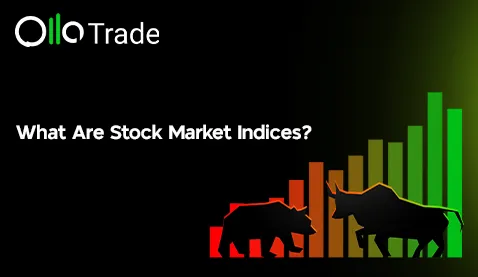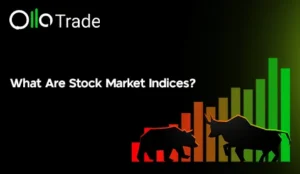Ever hear names like S&P 500, Dow Jones, or NASDAQ thrown around and wonder what they mean? You’re not the only one. These aren’t just fancy market terms; they’re stock market indices, and they help give a bird’s-eye view of how parts of the market are doing.
In this quick guide, we’ll walk you through what stock indices are, the different types out there, and how they work behind the scenes. We’ll talk real to help you get the hang of it. Let’s make sense of the market, one index at a time.
Understanding Stock Market Indices
Stock market indices might sound like finance jargon, but they’re just a way to keep track of how the market is doing. In simple terms, a stock market index is a group of selected stocks bundled together to give you a big-picture view of market performance. Instead of checking every single stock out there, indices help you see the overall direction things are heading.
It’s kind of like keeping an eye on the top teams in your favorite sports league; you don’t need every match’s score to know who’s leading. That’s what indices do: they offer a quick snapshot of how well certain sectors, or the market is performing. Whether you’re new to trading or just testing the waters, understanding indices is like having a compass. It won’t give you all the answers, but it’ll point you in the right direction.
What Is a Stock Index and Why Should You Care?
The stock index is a big snapshot of the market. While a single stock shows you how one company is doing, a stock index tracks the performance of a group of companies; kind of like checking the class average instead of focusing on just one student’s grade. It gives you a quick sense of how a section of the market is performing without diving into every individual stock.
For new traders, this is gold. Instead of chasing every chart and headline, watching an index can help you stay grounded and see the forest, not just the trees. Whether the market is having a good day or throwing a tantrum, it helps you read through the room and that’s a skill every smart trader need in their toolkit.
Types of Stock Market Indices
All stock market indices are not just fancy numbers that move on a screen. Some investors prioritize famous names, while others treat all stocks equally. Let us break it down in a way that makes sense.
Domestic vs. Global Indices
Domestic indices focus on stocks listed within a single country. For example:
- The S&P 500 reflects the U.S. market, track the largest companies.
- The Nifty 50 does the same in India.
On the flip side, Global indices go bigger. They include companies from multiple countries and offer a broader view of the world economy.
Quick tip: If you’re only watching domestic indices, you might miss the global domino effects that often shake the markets.
Price-Weighted vs. Market-Cap Weighted
Not all stocks have an equal voice on the index. Some shout louder, others whisper, and it depends on how the index is built. Price-weighted indices allocate more weight to equities with higher prices. So, a $400 stock will influence the index more than a $40 stock, even if the cheaper one belongs to a bigger company.
Market-cap weighted indices give weight based on a company’s total value in the market (market capitalization). So bigger companies like Apple or Microsoft carry more influence. This is more like voting power based on size, the louder its vote.
Popular Stock Market Indices You Should Know
Here are a few names you’ll hear tossed around a lot — and for good reason:
- S&P 500: Tracks 500 top U.S. companies, market-cap weighted. Often considered the best snapshot of the U.S. economy.
- NASDAQ Composite: Heavy on tech stocks like Apple, Amazon, and Google. Also, market-cap weighted.
- Dow Jones Industrial Average (DJIA): Includes 30 large U.S. companies, but price-weighted which can make it a little quirky.
- FTSE 100: A key index in the UK, representing the 100 biggest companies on the London Stock Exchange.
Each one brings a different flavor to the table, and knowing what they measure helps you read between the lines of market news.
How Stock Indices Work Behind the Scenes?
Let’s pull back the curtain and walk through how stock indices work.
Starts with Stock Selection
Think of an index like a curated playlist of songs, instead of music; it’s a carefully chosen list of stocks. Each index is built around a theme. For example:
- The S&P 500 includes 500 large U.S. companies.
- The KSE-100 reflects Pakistan’s top 100 publicly listed firms.
Index providers (like S&P Dow Jones, MSCI, or PSX) handpick stocks based on factors such as:
- Market capitalization (the value of a company)
- Industry sector
- How much company is reliable?
The goal is to make sure the index accurately reflects a specific part of the market. Whether that’s tech giants, energy stocks, or an entire country’s economic health is important.
Who Weighs More? Weighting Methods Explained
Once the list is ready, it’s time to decide how much influence each stock will have on the index. This is where “weighting” comes in. Here are the most common types:
- Market Cap-Weighted
Bigger companies carry more weight. So, if Apple sneezes, the whole index might catch a cold.
- Price-Weighted
Used by Dow Jones. Here, stocks with higher prices get more say; regardless of how big the company is.
- Equal-Weighted or Fundamental-Weighted
In some cases, every stock gets an equal vote, or they’re weighed based on earnings or revenue. It’s like deciding who gets to speak louder in a group based on size, price, or fairness.
Crunching the Numbers
Now comes the number game. But don’t worry — you don’t need to be a math whiz to get the gist. Here’s the simple version:
The total market value of all the selected stocks has been added. Then it’s divided into something called a “divisor” (It is a behind-the-scenes number that keeps things going smoothly).
In short: It is like a snapshot of how that group of stocks is doing overall.
Wrapping It Up
Stock market indices aren’t just numbers dancing on a screen; they’re like the market’s highlight reel. Whether you’re just starting out or trying to make sense of the daily buzz, knowing how indices work gives you a clearer lens on what’s really happening out there. Keep watching, keep learning — the market speaks, and indices help you understand the language.
If you’re a beginner then join Olla Trade Ltd to learn the ropes and track your first index clearly.









